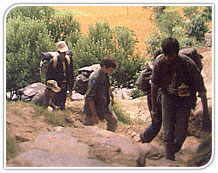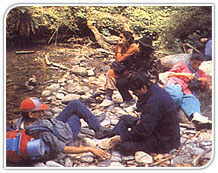Trekking In India
 For
those fascinated by the unexplored, the mountain ranges of India offer
breathtaking, enthralling trekking routes. In the vast amphitheatre of the
Indian Himalayas and Karakorams, there are limitless possibilities for
trekking, mountaineering, skiing, and river rafting. Within this alluring
arena, the Garhwal and Kumaon regions, occupy the central place, with
special points of interest for the trekker.
For
those fascinated by the unexplored, the mountain ranges of India offer
breathtaking, enthralling trekking routes. In the vast amphitheatre of the
Indian Himalayas and Karakorams, there are limitless possibilities for
trekking, mountaineering, skiing, and river rafting. Within this alluring
arena, the Garhwal and Kumaon regions, occupy the central place, with
special points of interest for the trekker.
Spectacular views
apart, the Himalayan foothills are just ideal for trekking, offering
energetic out-door people a different and exciting option for a holiday.
The Garhwal and Kumaon regions of Uttaranchal are the most popular
destinations for trekkers, though Chamba and Manali in Himachal Pradesh,
and Ladakh and Zanskar in Jammu and Kashmir, have interesting trekking
routes as well.
 Darjeeling
and Sikkim in the east also have some trekking routes. While trekking as a
sporting activity does not require prior training or practice, except that
the trekker should be in good physical condition, there are certain dos
and don'ts which should be adhered to. Routes should be carefully chosen,
as some treks may be more difficult, or may involve high altitude
trekking. It is generally advisable to be accompanied by a local guide.
Ensure that the pace of the trek is not too rapid, since this could result
in exhaustion, and would in any case not be enjoyable.
Darjeeling
and Sikkim in the east also have some trekking routes. While trekking as a
sporting activity does not require prior training or practice, except that
the trekker should be in good physical condition, there are certain dos
and don'ts which should be adhered to. Routes should be carefully chosen,
as some treks may be more difficult, or may involve high altitude
trekking. It is generally advisable to be accompanied by a local guide.
Ensure that the pace of the trek is not too rapid, since this could result
in exhaustion, and would in any case not be enjoyable.
The
adventure season, which till recently, was confined to the summer months,
now covers almost the entire year, including winter. This has been made
possible by improved equipment and transportation, and the availability of
year-round bookings in areas, hitherto, considered inaccessible. Moreover,
winter treks are gaining popularity as a means of 'getting away' to
relatively lower altitudes.
Precautions and Permits
Precautions:
It is advisable to be medically examined before starting a trek. The first
aid kit for the trek, should include basic medicines and bandages for
cuts, burns, headache, nausea, constipation, diarrhoea, and sore throat.
Running water should be used for washing, and washing should be done well
downstream of campsites. Keep a map handy, and set a comfortable pace.
Allow for time to enjoy the panoramic and magnificent sites of the awesome
mountains, rivers, flora and fauna.
 Permits:
Indian nationals need no permission for trekking in any area, outside the
Inner Line. For routes inside the Inner Line, the local District
Magistrate's permission, or that of the Central Home Ministry is
necessary. For foreigners, crossing the Inner Line is not permitted. Treks
upto 4900 mts need no permission, and can be undertaken on tourist visas.
For treks above 4900 mts, prior permission is to be taken from the IMF.
Camera permits are also necessary.
Permits:
Indian nationals need no permission for trekking in any area, outside the
Inner Line. For routes inside the Inner Line, the local District
Magistrate's permission, or that of the Central Home Ministry is
necessary. For foreigners, crossing the Inner Line is not permitted. Treks
upto 4900 mts need no permission, and can be undertaken on tourist visas.
For treks above 4900 mts, prior permission is to be taken from the IMF.
Camera permits are also necessary.
Equipment
and Insurance
Equipment: A firm rucksack with
broad straps, sleeping bag, foam mattress, comfortable walking shoes,
raincoat, torch, matchboxes, umbrella, and water bottles are essential.
Personal clothing including woollen shirts, pullovers, T-shirts, feather
jacket, longjohns, toilet items, camera and film, should be included to
suit the duration and altitude of the trek, while keeping the overall
weight to the minimum.
Insurance:
This is possible through the standard insurance companies. The IMF, Indian
Air Force, and local authorities should, as far as possible, be kept
informed of the route.
Grading of TreksThe treks
described have been graded according to their level of difficulty.
Grade
1:: Soft trek, round the year
Grade 2: Seasonal / mild
trek (April - November)
Grade 3: Tough, high altitude trek
(seasonal)
Trekking
Routes:
Some of the Popular Trekking Routes:
The
Har-ki-Doon Trek (Grade 1)
The
Chandrashila Winter Trek (Grade 1)
The
Dehradun - Kempty Falls Trek (Grade 1)
The
Rishikesh - Gopeshwar Trek (Grade 1)
The
Gangotri - Kedarnath Trek (Grade 2)
The
Kedarnath - Vasukital Trek (Grade 2)
The
Kalindikhal Trek (Grade 3)
The
Pithoragarh - Sinla Pass Trek (Grade 3)
For those fascinated by the unexplored, the mountain ranges of India offer breathtaking, enthralling trekking routes. In the vast amphitheatre of the Indian Himalayas and Karakorams, there are limitless possibilities for trekking, mountaineering, skiing, and river rafting. Within this alluring arena, the Garhwal and Kumaon regions, occupy the central place, with special points of interest for the trekker.
Darjeeling and Sikkim in the east also have some trekking routes. While trekking as a sporting activity does not require prior training or practice, except that the trekker should be in good physical condition, there are certain dos and don'ts which should be adhered to. Routes should be carefully chosen, as some treks may be more difficult, or may involve high altitude trekking. It is generally advisable to be accompanied by a local guide. Ensure that the pace of the trek is not too rapid, since this could result in exhaustion, and would in any case not be enjoyable.
Permits: Indian nationals need no permission for trekking in any area, outside the Inner Line. For routes inside the Inner Line, the local District Magistrate's permission, or that of the Central Home Ministry is necessary. For foreigners, crossing the Inner Line is not permitted. Treks upto 4900 mts need no permission, and can be undertaken on tourist visas. For treks above 4900 mts, prior permission is to be taken from the IMF. Camera permits are also necessary.